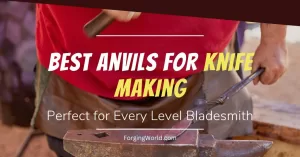Starting on your journey as a blacksmith or bladesmith can be overwhelming, especially when it comes to finding the right tools.
In this article, we’ll explore the essential tools you’ll need to forge a throwing axe, along with some affordable alternatives for those just starting.
Tools You Need to Forge a Throwing Axe
| Tool | Basic Tool | Alternative |
|---|---|---|
| Forge | Gas Forge | Charcoal Forge |
| Anvil | Quality Anvil | Railroad Track, Flat Steel, or Concrete Slab |
| Hammer | Blacksmith’s or Cross-Peen Hammer | Nail Hammer or Sledgehammer |
| Tongs | Blacksmith Tongs | Heavy-Duty Pliers or Vise Grips |
| Files and Grinders | Belt Grinder | Angle grinder, Files, or Sandpaper |
| Heat Source for Tempering | Electric or Gas Oven | Forge, or MAPP Torch |
| Quenching Tank | Dedicated Quenching Tank with Quenching Liquid | Heat-Resistant Container with Quenching Liquid |
Forge: The Heart of Your Workshop
Gas Forge
A gas forge is the most common choice for heating steel in blacksmithing and bladesmithing. It provides consistent heat and is relatively easy to operate.
Check out this list of the best gas forges for knife making.
Charcoal Forge (Alternative)
If you don’t have access to a gas forge, you can build a simple charcoal forge using a brake drum or a fire pit with an air supply to provide the necessary heat. Charcoal forges require more maintenance and fuel but can be a cost-effective option for beginners.
Anvil: The Foundation for Shaping
Quality Anvil
A good-quality anvil is essential for shaping your steel. It provides a sturdy, stable surface for hammering and forming your throwing axe. Browse these best anvils for knife making for recommendations.
Railroad Track or Flat Steel (Alternative)
If you don’t have an anvil, you can use a section of a railroad track or a large, flat piece of steel as a makeshift anvil. Although not as efficient as a proper anvil, these alternatives can work for beginners on a budget.
Hammer: Your Trusted Shaping Companion
Blacksmith’s or Cross-Peen Hammer
A blacksmith’s or cross-peen hammer is ideal for shaping your throwing axe. It’s designed specifically for blacksmithing tasks and offers optimal control. Find out what is the best hammer for knifemaking in this article.
Ball-Peen or Sledgehammer (Alternative)
If you don’t have a specific blacksmith’s hammer, you can use a heavy ball peen or a sledgehammer as a temporary solution. These hammers are more readily available but may not provide the same level of control and precision as a blacksmith’s hammer.
Tongs: Handling Your Work Safely
Blacksmith Tongs
Tongs are essential for safely holding and moving your heated steel. Blacksmithing tongs come in various shapes and sizes to accommodate different types of workpieces. Investing in a good set of tongs ensures better control and safety while working with hot metal.
Heavy-Duty Pliers or Vise Grips (Alternative)
If you don’t have tongs, you can use heavy-duty pliers or vise grips as an alternative. While not as secure and comfortable as tongs, these tools can still help you handle hot steel when working with a limited budget.
Files and Grinders: Shaping and Sharpening Your Axe
Belt Grinder
A belt grinder is ideal for shaping and sharpening your axe blade. With various grit belts, you can achieve a clean and precise finish on your throwing axe. It’s an essential power tool for any serious bladesmith or blacksmith.
Files (Alternative)
If you don’t have a belt grinder, you can use files to shape and sharpen your axe blade. Files come in different shapes and sizes, allowing you to achieve a decent finish on your axe. While more time-consuming and labor-intensive than a belt grinder, files can be a budget-friendly alternative for beginners.
Heat Treatment: Hardening and Tempering Your Axe
Electric or Gas Oven
An electric or gas oven is a convenient option for tempering your axe, providing precise temperature control. Proper heat treatment is crucial to achieving a strong, durable, and functional throwing axe.
Forge (Alternative)
If you don’t have an oven, you can use your forge for tempering by carefully controlling the temperature and following the ultimate guide to tempering a knife. While more challenging to maintain consistent temperatures, using your forge for heat treatment can save you money and space.
Quenching Tank: Hardening Your Axe
Dedicated Quenching Tank
A quenching tank filled with an appropriate quenching liquid is needed to harden your axe after forging. Proper quenching is vital for achieving a durable, high-performance throwing axe.
Heat-Resistant Container (Alternative)
If you don’t have a dedicated quenching tank, you can use any large, heat-resistant container filled with quenching liquid, such as a metal bucket or a deep, sturdy plastic tub. Make sure the container is large enough to fully submerge your axe and can withstand the heat of the hot steel.
Final Thoughts
Armed with this knowledge, you’re ready to gather your tools and start forging your very own throwing axe. Remember, practice makes perfect, and with time and dedication, you’ll master the art of bladesmithing.



